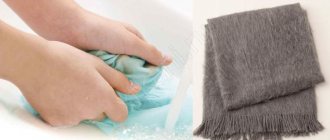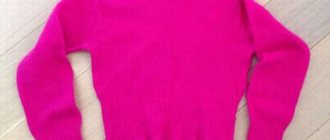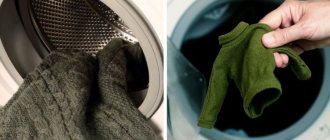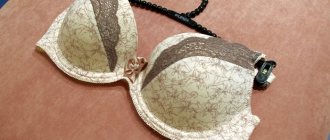Sweaters and pullovers are in every person's wardrobe. Caring for such products includes washing and drying.
If you deviate from the rules, the sweater may become deformed: shrink or stretch. Instructions and recommendations will help you cope with the situation.
We will tell you in this article how to properly wash a sweater (acrylic, cashmere, etc.) in a washing machine and by hand.
Can it be washed and how often?
The manufacturer indicates the possibility of washing by hand or in a machine on the label on the item, which is sewn on the inside.
Depending on the resistance of the product to wet processing, the method of further cleaning is determined. Knitted items are demanding in terms of care and operating conditions .
Washing knitted items too frequently and unnecessarily can lead to pilling and a decrease in the service life of the product.
Careful wearing of the item, airing it, and proper storage will help prolong its operation . You should not experiment with washing if the product label prohibits such processing.
Disadvantages of things made of acrylic
How to remove stains?
Each type of fabric requires special treatment. If you do not follow the rules of machine washing, clothes and products will quickly become unusable.
Cotton and linen
Items of this quality are washed strictly separately from other laundry. It is allowed to place no more than 6 kg dry in the drum. For colored items, the temperature does not exceed 40 degrees, white items are processed at 95 degrees. Spinning takes place at 800-1400 rpm.
Delicate fabrics
It is better to wash “capricious” materials at a temperature of 30 degrees with a minimum drum load. The optimal weight is 1 kg. RPM – no more than 1200. Many fabrics cannot withstand long-term mechanical stress; the cycle must proceed quickly.
Synthetics
Synthetic items should be cleaned gently at a temperature not exceeding 30 degrees. The fibers quickly become clean; they should not be processed for long. Turn on spin at 600 rpm.
How many program options do manufacturers of household appliances offer for washing machines? It is difficult to answer the question; each model has its own unique set. One mode or function can represent different tasks. To use the unit correctly, you must carefully study the instructions and useful tips.
The article has been verified by the editors
On the reverse side of the product you must find a label indicating the composition of the material, the washing and ironing temperature, as well as the possibility of using mechanical washing.
When machine washing, gentle modes are used:
- “delicate”, provides a temperature of no more than 30°C;
- “hand” means gentle washing;
- The “synthetic” program is provided for acrylic, “wool” is also suitable.
When choosing programs, you must ensure that the revolutions are in the range of 300-500 per minute, if turning off the spin is not possible and the water temperature does not heat up above 40°C.
We invite you to familiarize yourself with How to wash soft toys - 80 photos and videos on how to properly wash a soft toy at home
Preliminary preparation includes:
- If there are stains, they must be removed before washing.
- If the product is heavily soiled, you can soak it in a cool soapy solution for 15-60 minutes.
- Turn out the pockets and remove all contents from them.
- Fasten the buttons and zippers, turn the item inside out.
- Acrylic products must be placed in a special mesh bag. This will protect them from stretching and friction while the centrifuge is running.
- Pour detergent intended for synthetics into the soap compartment.
- In the rinsing compartment - rinse aid or table vinegar - 9% (1/3 cup).
- Double rinsing is encouraged.
Despite the durability of the paint, white products lose their whiteness, become washed out and gray. This occurs when using products containing chlorine, frequent improper washing with other things, and increased hardness of tap water. If industrial products do not help, you can use a soda solution (5 tbsp) for whitening.
Sweatshirts and cardigans made of acrylic require special care. This is due to the fact that synthetic fibers are afraid of hot water, and heavy soiling cannot be washed off in cold water. Therefore, do not wear out the item, try to wash it every few days. In addition, acrylic jumpers are prone to pilling. To prevent them from appearing, add fabric softener or fabric softener to the water during washing.
If you prefer to wash by hand using laundry soap, for light-colored acrylic items, purchase a light-colored soap. When washing, use plenty of clean water; artificial fibers firmly hold the alkali contained in the powder and it must be rinsed thoroughly. After washing, it is recommended to squeeze the product by hand so as not to stretch the thin fibers.
Before answering this question, you need to figure out what kind of thing is in front of you. Carefully examine the label sewn onto the reverse side of the sweater. If it states that the item is 100% synthetic fiber, it can be machine washed. Most products contain both synthetic and natural fibers, such as wool, cotton, and angora.
Washing algorithm
Step-by-step algorithm for hand washing:
- a stain formed on a sweater requires pre-soaking;
- greasy stains can be washed off with laundry soap;
- It is not recommended to strongly rub the sweater fibers against each other;
- rinse the product thoroughly in clean water after washing;
- while rinsing, add 1 tbsp of vinegar to the water;
- After washing, gently squeeze out the water and let it drain on its own;
- Wrap the sweater in a towel to absorb excess moisture.
Machine wash algorithm:
- first remove all stains from the product;
- It is not recommended to overload the drum with other things; leave it half free;
- turn the sweater inside out and load it into the machine;
- in addition to the powder, be sure to add rinse aid;
- set the “Wool”, “Synthetics” or “Delicate Wash” mode;
- permissible water temperature 40 degrees;
- turn off the “Spin” and “Drying” modes.
How to remove stains?
All stains on an acrylic product must be removed before the main wash. Soak the sweater in cool water and treat the stain. It is advisable to remove all stains immediately before they become embedded in the fibers, but old stains can also be dealt with. It's difficult to combat stains with water alone, so you'll need cleaning products.
Dilute washing powder or laundry soap in water. After lowering the sweater into the basin, gently rub the stain and leave the sweater to soak for 20-30 minutes. This time is enough for the alkali to penetrate the fibers and remove the stain. After this, you can begin the main wash.
Knitted items are an indispensable item in the wardrobe of almost any person. In order for your sweater to serve you for as long as possible, you need to take proper care of them. Study the label or label; it contains information on how to properly clean the product.
It is advisable not to wash them after a single use; if there are no obvious signs of dirt or stains, you can hang them outside or on an open balcony for ventilation. Washing too often wears out the wool fibers and the clothes lose their appearance. Inspect the pullover to see if there are any holes, loose loops, whether all seams are intact, and if any defects are found, eliminate them.
If there are stains, before loading them into the machine or hand washing, they must be removed using vinegar or other products suitable for the specific type of yarn. How to wash a sweater in a washing machine, depending on the composition of the yarn, read our article.
Woolen
Wool items shrink easily, and if proper cleaning procedures are not followed, your clothing may shrink several sizes:
- washing in a machine is allowed if the wool content of the yarn is no more than 50 percent;
- no pre-soaking required;
- do not mix things of different colors;
- Before putting it in the drum, turn the pullover inside out;
- to prevent pellets from appearing, you can use special rubber balls or regular tennis balls;
- use a washing bag; if you don’t have one, you can use a pillowcase; don’t forget to sew up the free edge so that the pullover doesn’t fall out during the washing process;
- the temperature should not exceed 30 degrees;
- washing mode - wool;
- spinning and drying are turned off, since during spinning the yarn gets tangled and shrinks;
- Choose a detergent special for wool, which contains lanolin. There are a large number of them on sale - “Laska”, “Cashmere”, “Pervol”, choose in accordance with your financial capabilities and the degree of trust in the manufacturer. In extreme cases, you can wash it with hair shampoo, but it will be more difficult to rinse;
- use rinses, after their use the product becomes softer and fluffy, and less electrified when worn.
Acrylic
When cleaning acrylic yarn items, follow the manufacturer's directions on the label. As a rule, acrylic does not require such scrupulous treatment as wool. You can use any washing powder or gel according to the color of the pullover.
The temperature is set, as a rule, to 40 degrees; if the temperature is set higher, the product may stretch. Set the spin speed to no more than 500. To soften, you can use conditioner.
From angora
Angora yarn, like cashmere yarn, is made from the down of special breeds of goats. Angora products are very cozy, warm and fluffy. But caring for them requires a very careful attitude. It is not recommended to wash 100 percent angora in a machine; the item may become very matted.
If the composition contains at least 50 percent synthetics, machine washing is possible subject to the following recommendations:
- turn the product inside out and place it in a special laundry bag;
- the temperature should not be higher than 30 degrees;
- turn off spinning and drying;
- use special detergents for washing angora;
- to restore fluffiness, after washing you can soak the jumper in lukewarm water, to which 2 tbsp is added. spoons of ammonia and 1 tbsp. spoon of turpentine. It is enough to keep the pullover in the solution for half an hour.
We suggest you familiarize yourself with How to wash a blanket by hand, in a washing machine, foam cleaning and proper drying
Sheep
If your sheepskin sweater is knitted from synthetic-free yarn, it is better to wash it by hand. Since washing in a washing machine can damage it irrevocably - it will become matted and it will be impossible to fix it.
Blended yarn with a synthetic composition of at least 50 percent can be washed in a machine, following the recommendations:
- wool or hand wash mode;
- temperature no more than 30 degrees;
- special detergent containing lanolin;
- without using spin and dry options;
- You can use conditioner to make it softer.
Cotton
White cotton jumpers should be washed at temperatures from 40 to 90 degrees, depending on the manufacturer's recommendations. Colored at a lower temperature, from 30 to 60 degrees.
The detergent is also selected depending on the color; when cleaning white items, you can use powders with bleaches. The mode is selected for cotton, spin can be set up to 800 rpm. If there is heavy soiling, use the pre-wash option.
- The fabric does not absorb moisture well. The body in clothes made from it quickly sweats.
- There is virtually no breathability. The skin doesn't breathe well.
- During wear, pellets appear on the surface, which significantly spoils the appearance of the products.
- Things become electrified, so it is necessary to constantly use antistatic agents, which do not always help. The problem worsens if you dry acrylic clothes at elevated temperatures (for example, on heating radiators).
- As a result of long exposure to the sun, the canvas loses its softness and richness of color.
- Acrylic fabric easily develops greasy and difficult to remove stains.
- If the fabric is of poor quality, it quickly loses its shape and stretches.
Washing in a washing machine
If the sweater manufacturer allows machine washing, then follow the instructions. Important points are the choice of mode, temperature indicators and the detergent used.
To wash sweaters, the drum should not be fully loaded. Recommended – no more than 2/3 of the volume.
Procedure:
- You need to make sure that there are no brooches or other removable decor on the item, and that the sweater itself does not need to be repaired.
- Turn the product inside out.
- Place the sweater in a laundry bag. If it is not available, put it in a pillowcase, which should be fastened or tied.
Pour a dose of detergent in gel form into the container. It is preferable to washing powder.- Place the sweater in the drum.
- Select the “delicate” or “manual” mode. For woolen clothing, "wool" can be used.
- Set the temperature to +30ºС, unless otherwise permitted by the manufacturer.
- Set the spin to minimum (if the material is dense and not loose) or turn it off completely (preferably for hand-knitted items).
- Start the wash cycle.
- After finishing the processing, you must immediately remove the item from the drum, wring it out and begin drying according to all the rules.
How to wash a wool sweater
Wool sweaters require more attention than synthetic ones. Many of them may have labels that recommend hand washing or dry clean only. The question is: are such recommendations the only possible solution?
The main problem with washing wool sweaters and wool sweaters is that they can shrink. And this is very sad. How can you tell whether this particular sweater can be washed in a machine or only by hand? It is worth carefully studying the composition - if wool is only one of the components, and there is no more than 50% of it in the sweater, and the rest is acrylic, then the sweater can be sent to the machine with certain precautions.
To wash wool, you need to choose the “Hand Wash” or “Wool Products” modes and the most delicate cleaning products (the ideal option is special products for wool). Do not subject wool items to intensive machine drying. To ensure that a freshly washed sweater does not lose its shape, it must be dried according to the rules. If you have other items in your wardrobe that contain six, such as Burberry scarves, wash them according to the same rules as your clothes.
The wet wool sweater should be laid out on a clean towel, giving it the correct shape and size. It is important to ensure that the product does not deform or shrink. Cover with a second towel, carefully roll into a roller and squeeze very carefully with your hands so that the towel absorbs excess moisture. Remove the first towel and repeat again. After such a gentle spin, the sweater should be laid out vertically on a dry towel and left to dry, but be careful that it does not dry out.
How to do it manually?
Processing a sweater by hand is a gentle washing option that allows you to control the process at all stages.
For washing, it is necessary to prepare a large container, taking into account the fact that a wet item becomes bulky.
Instructions for this type of washing include the following steps:
- Inspect the product. If there are defects on it (for example, loose seams), they must be eliminated before washing.
Water at a temperature of +30ºC is poured into a large container (basin or bathtub).- Dilute the detergent in water until completely dissolved, following the instructions on the package.
- Dip the sweater into the water.
- Leave for no longer than 10 minutes.
- Wrinkle the item slightly, paying attention to the collar and cuffs.
- The water is drained, and the pullover itself is slightly wrung out.
- Rinse the item in clean water, changing it several times.
You can add fabric softener to the water during the last rinse to increase its softness.
How to wash a cashmere sweater
Cashmere, of course, is the best material for a sweater - beautiful, warm and most delicate. True, these sweaters are not cheap at all and are the most demanding to care for. Regardless of what is written on the label of your beautiful cashmere sweater, you can wash it, in the best case, only by hand, with all possible care and caution.
While a cashmere sweater can still be washed at home, cashmere coats should definitely go to the dry cleaner. And if you do send your most delicate and expensive sweaters to the dry cleaner, do not forget to unpack them as soon as you bring them home. The sweater must be taken out of the plastic bag, otherwise it may get damaged.
Features for various materials
The difficulty of washing knitted clothes is due to the need for delicate processing. All important factors must be taken into account:
- type of material;
- color and its durability;
- hand/machine knitting;
- quality of tailoring, etc.
Made from wool
Most sweaters, especially those made from wool and angora, should not be soaked for long periods of time. This material is sensitive to high and low temperatures.
High temperature causes the item to shrink . And it can seriously decrease in size.
Particular care should be taken with items that are hand-knitted. The texture of such a sweater is looser than that made by machine knitting.
With careless care, serious deformation, change in size, and even the appearance of the item may become so poor that it will no longer be possible to wear it. You cannot rub woolen fabric during washing - it will become rough and tough .
Read about proper washing of wool sweaters here.
Made from acrylic
Acrylic fabric is warm, although it has a synthetic composition. Soft and cozy, such sweaters are easier to wash when compared to woolen items. Acrylic also tolerates contact with water more easily, practically does not wrinkle and does not lose its shape.
This sweater can be machine washed at a low temperature (no more than +40ºС). Spinning can also be done, but at minimum speed. You cannot rub or wrinkle a wet item to avoid deforming it.
If the item is worn out, it is possible to pre-soak it in a solution of liquid detergent (even liquid soap will do). After a quarter of an hour, the item is rinsed and washed in a machine or by hand.
The exception is chunky knit and handmade sweaters. The same rules that apply to woolen products must be applied to them.
Cotton
Sweaters knitted from cotton threads are hypoallergenic. They do not irritate the skin and are able to retain heat.
The peculiarity of such clothes is that during wear and after several washes, pills may appear on them .
The processing temperature is determined by the label. In principle, such yarn can withstand even temperatures above +30ºС. But for each thing this parameter is determined separately.
It is affected by:
- color fastness;
- texture of thread weave;
- looseness of knitting, etc.
Even for white cotton pullovers, you should not use chlorine detergent.
Cashmere
A soft and very comfortable cashmere sweater - warm and practical. You can wash such a thing, but not too often, preferably by hand, since washing in a machine and spinning even at low speeds can lead to stretching of the product and the formation of pills.
The elastic yarn used in these sweaters requires very careful handling. Rinsing should be thorough, with multiple changes of water to ensure that the detergent is completely rinsed out of the fibers.
How to wash a cashmere sweater, video tips:
Seven ways to get rid of pellets
Many ways have been invented to remove pellets from a dress or pants. Some techniques are only suitable for certain types of fabrics; use with other materials may not only not produce results, but also ruin the appearance of the item. Many methods are worth taking note of, but some are skeptical and can only be used at your own peril and risk.
The most effective surface cleaning methods:
- Using a special machine;
- Removing pellets using a razor;
- Using a hair clipper;
- Textile fastener;
- Scissors;
- Comb;
- Scotch;
- Sticky roller.
Now in more detail about each method.
Special machine
You can effectively and quickly remove pellets and remove excess lint from the surface of clothing using a machine. It does not have a special name, but occasionally it is called “Trimmer”. Its operating principle is the same as that of an electric razor with rotating knives. Unless the size of the working surface and the size of the grid cells are larger. In addition, each device has a removable waste container. During operation, the mesh surface is pressed against the fabric. The pellets and fluff that fall into the cells of the protective mesh are cut off by knives that rotate at high speed. Advanced models have adjustment of the length of the cut pile, which can be useful when processing various types of fabrics.
Hair clipper
A clipper will clean your clothes in a similar way. The difference is that the working tool works on the principle of scissors. Using attachments and adjusting the knives also allows you to change the length of the trimmed pile within a wide range. It is necessary to ensure that folds of fabric and elongated loops do not get caught in the moving knives, as they will be cut off. A serious drawback is that such devices are designed to work with coarse and coarse hair. Yarn fibers are always much softer and can get between the working surfaces and cause the device to malfunction.
Safety razor
The problem of pills on smooth fabric can be successfully solved with an ordinary razor. It doesn't matter if it has replaceable blades, one blade or multiple blades. To clean, the machine is effortlessly leaned against the surface of the clothing and the pellets are cut off, as when shaving. The main attention should be paid to ensuring that the surface of the fabric is smooth, without folds, which, if caught under the knife, will be cut off. For this reason, the use of new blades and razors is not recommended. It is advisable to take ones that are already slightly dull. The problem is cleaning the machine from accumulated debris, especially with multi-blade machines with non-removable blades. It can be cleaned using a sharp match or toothpick. This method is good for cleaning smooth fabrics, in particular bedding.
Comb
You can remove pellets from a wool, acrylic or cashmere jumper using a fine-toothed comb. This method, in addition to cleaning, also improves the appearance of things. For optimal effect and to prevent puffing, the comb should be parallel to the surface of the fabric.
Scissors
If there are a small number of lumps, they can be removed using scissors. The spools are carefully cut off, holding the tool close to the surface and parallel to it.
Apply the methods listed above when things are put on, especially knitwear, tights, and coats.
Velcro
The remaining methods work on the same principle, but with different materials. You can find inexpensive rollers for cleaning clothes on sale. A roller with a sticky layer not only removes dirt and dust from things, but also removes matted lint. If the adhesive tape on the roller becomes dirty, it needs to be replaced. If you don't have a roller, you can use tape. To clean, the tape is unrolled from the roll and applied to the clothing with a sticky layer, and then removed along with the adhered lint and pellets.
Textile Velcro, the side with miniature plastic hooks, effectively removes pellets. The disadvantage of this method is that after use it will be hopelessly damaged.
- Does cotton shrink after washing and how to avoid deformation of things?
Removing pills from clothes using the listed methods has a significant drawback. Not only pellets stick to the adhesive tape or hooks, but also yarn fluffs, which under normal conditions do not interfere. When the adhesive tape is torn off, these fibers are pulled out and can form puffs, especially on large knitted items. The elongated fibers will fall off again in a very short time and the procedure will have to be repeated.
Nuances depending on the color of the product
Only items of the same color, composition and texture can be taken into one load of a washing machine or hand wash . Even when made from non-fading yarn, white and black items cannot be washed together.
It is optimal to use gel products for washing, which are intended for wool or delicate items. There are special household chemicals intended only for black or only for white products.
For light-colored pullovers, it is important to give preference to gels and powders that do not contain chlorine. If you don’t have a special product for white and black on hand, you can use a universal product for colored clothes.
When choosing a new product, you must first study the instructions for it to make sure that sweaters can be washed.
How to wash a fabric item so that it shrinks one or two sizes?
Knitted items stretch quite often. Hand-knitted items deform especially quickly, since they have a low density of loops. It is not easy to return them to their previous size, since almost all types of yarn contain some amount of synthetic additives. Acrylic is more susceptible to stretching.
- Preparation. Before washing the product, you need to place it in a special bag. If you don’t have a bag, you can sew one from old tulle. The open side of the bag must be tied or sewn.
- Mode selection. Set the mode to “wool” or “delicate fabrics”. Adjust the water heating level. The maximum permissible temperature for knitted items is 60 degrees.
- Detergent. You can use regular powder, but it is better to give preference to liquid products. Powder for baby clothes is also suitable.
- Adjusting the spin program. Theoretically, at high speeds, the yarn gets confused and can therefore decrease in size. However, in practice this does not always work out. The result is influenced by the composition and twist of the threads in the yarn. For this reason, you first need to spin the clothes at medium speed. If after this the product does not shrink enough, you can set the spin mode at high speeds and re-process the item.
If the sweater or dress is made of very delicate yarn, it is better to use the hand wash method. In this case, the algorithm will be as follows:
- soaking in hot water with the addition of conditioner;
- rinsing;
- soak in cold water for 10 minutes;
- spin through a terry towel without twisting;
- drying on a horizontal surface.
Is it possible to restore a shrunken item?
Natural yarn tends to shrink when exposed to hot water or contrasting temperatures.
Taking this into account, sweaters are washed and rinsed in water at approximately the same temperature.
If the pullover does shrink, you can try to wet it and stretch it . But guaranteeing success is difficult.
You can find out more about the issue in this article.
Is it possible to restore the shape of a stretched pullover?
An increase in size of your favorite sweater after washing is an unpleasant event. Not every item can be restored. Features are related to the composition of the fabric, the type of knitting, and the model.
For natural yarn, you can use the property of yarn shrinkage from exposure to high temperatures. To do this, you can, for example, briefly soak the item in hotter water.
In this case, you need to act carefully, avoiding common mistakes - twisting the product and hanging it on a rope to dry.
More details about the question can be found here.
Proper drying
A sweater that has just been washed is wet and heavy. If you hang it on a trempel or throw it over a rope, deformation cannot be avoided.
After the item is washed and rinsed, it is wrung out very carefully through a terry towel . Do not apply excessive pressure or twist at this stage.
After this, the item is laid out freely on a horizontal surface on a soft, moisture-absorbing fabric. For example, on a terry bath towel.
Do not try to speed up the drying process:
- using open fire;
- hanging on hangers;
- hanging on the battery, etc.
In order to refresh an item made of natural wool, it is advisable to air it after wearing it.
Requirements for washing woolen items
Wool is a more capricious material. Not every item made from it can be washed in an automatic machine. It all depends on the composition of the fabric. If less than 50% wool was used in the manufacture of a sweater, and the rest is pure synthetics, a washing machine will most likely not spoil such a product. However, you should play it safe and turn off the drying and spinning modes.
In other cases, woolen items should only be washed by hand. How to wash a wool sweater without unpleasant consequences?
- The sweater must be turned inside out.
- After this, draw warm water no higher than 30 degrees and dissolve washing powder in it. For very thin, delicate items made of wool, baby shampoo or a special product designed for washing such items is suitable.
- Woolen clothes should be soaked for 5-10 minutes, lightly wrinkled with your hands, and then drained.
- After this, the sweater is rinsed and the water is allowed to drain, pressing lightly. You can't twist it too much. This way you can stretch the product very much.
- Dry woolen clothes on a flat surface in a horizontal position on a thick towel or clean sheet.
- You need to iron such things very carefully. The iron should not be pulled across the surface, otherwise the product will lose its shape. It needs to be lightly leaned against the fabric and lifted.
Answering the question of housewives: how to wash a woolen sweater, experts advise, in addition to following these rules, to sweep away buttonholes so that they do not become larger during the washing process.
Tips for housewives: how to easily wash wool?
Useful tips for washing woolen items. Part 1
Big wash - Everything will be fine - Issue 345 - 02.24.14 - Everything will be fine - Everything will be fine
Dry cleaning
Dry cleaning of knitted clothes offers customers the use of modern biotechnologies and professional equipment from leading manufacturers.
It is necessary to seek the services of professionals in cases where:
- the sweater cannot be washed - there is information about this on the label;
- the item has many decorative elements;
- the material fades;
- there is a danger of ruining an expensive item due to lack of experience in complex washing and difficult drying.
Dry cleaning will also help in cases where you don’t have time to do the laundry yourself.
The price will depend on several factors:
- material of the thing;
- provision of additional services (stain removal, etc.);
- sweater model;
- the presence of inserts from other materials, fittings, etc.
You can find a suitable dry cleaner on the Internet. Most of them work with electronic applications and accept orders by phone.
Items from the client are picked up by the courier, so you don’t have to waste your time first delivering the item and then picking it up. The cost of dry cleaning services on average is from 600 rubles.











